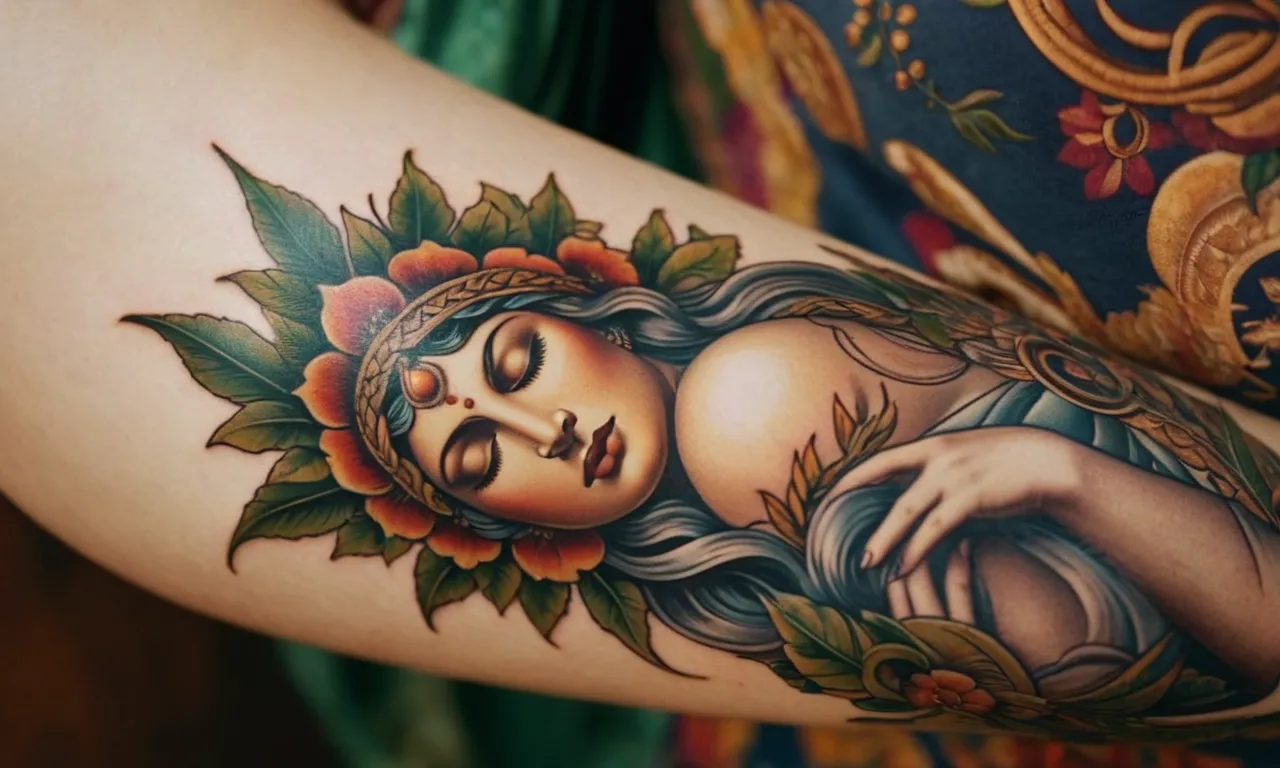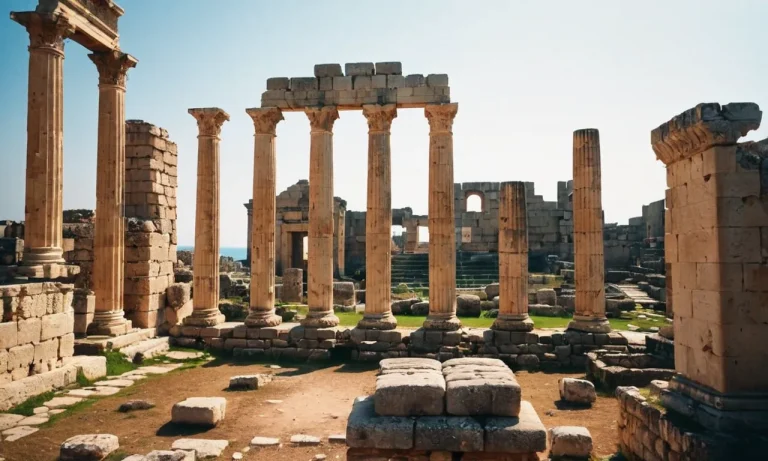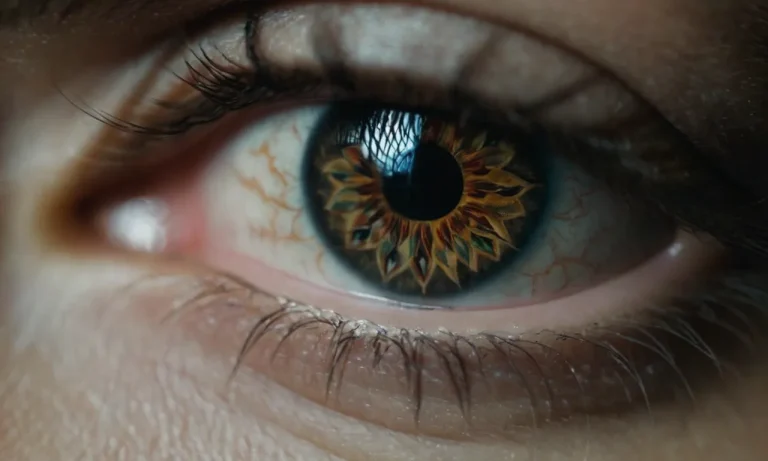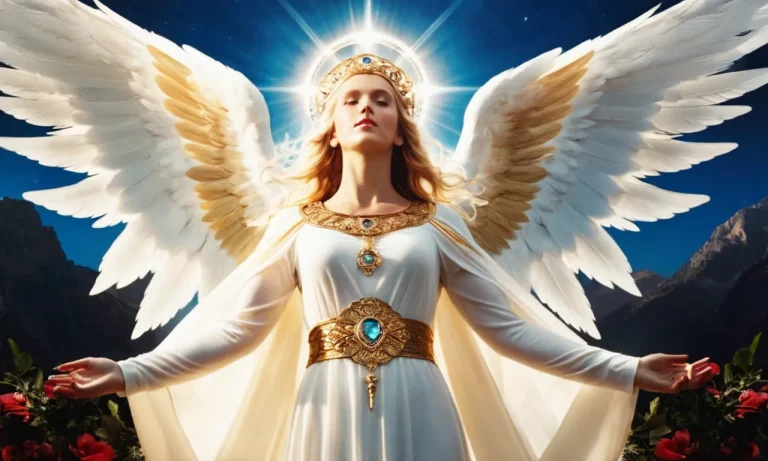Demeter Tattoo Meaning: Exploring The Symbolism Behind This Ancient Greek Goddess
In the realm of ancient Greek mythology, few deities hold as much significance as Demeter, the goddess of agriculture, fertility, and the sacred cycle of life. Her name has echoed through the ages, inspiring countless works of art, literature, and even tattoo designs.
If you’re considering adorning your body with a Demeter tattoo, you’re embarking on a journey that delves into the depths of one of the most revered and powerful figures in the Greek pantheon.
If you’re short on time, here’s a quick answer to your question: A Demeter tattoo symbolizes fertility, abundance, and the cyclical nature of life and death. It represents the nurturing and life-giving aspects of the natural world, as well as the resilience and strength required to endure the cycles of growth, decay, and rebirth.
In this comprehensive article, we’ll explore the rich symbolism behind Demeter tattoos, delving into the goddess’s mythology, her role in ancient Greek culture, and the various interpretations and meanings associated with her image.
We’ll also examine the different design elements and styles that can be incorporated into a Demeter tattoo, ensuring that you have a thorough understanding of this powerful and enduring symbol.
The Mythology of Demeter
The Mother Goddess and Her Daughter Persephone
In the realm of Greek mythology, Demeter stands as the revered goddess of harvest, agriculture, and fertility. Her profound connection with the earth and its bountiful cycles made her an integral figure in ancient Greek culture.
Demeter’s story is intertwined with that of her beloved daughter, Persephone, whose abduction by Hades, the god of the underworld, sparked a series of events that forever shaped the world.
The Abduction and the Descent into the Underworld
According to the myth, while Persephone was frolicking in a field, gathering flowers, the earth suddenly opened, and Hades emerged, abducting her to the gloomy depths of the underworld. Demeter, consumed by grief and anguish, withdrew her blessings from the earth, causing crops to wither and famine to spread across the land.
In her unrelenting search for her daughter, Demeter roamed the world, leaving a trail of barren landscapes in her wake. According to the ancient Greek sources, it was not until Hermes, the messenger of the gods, intervened that Persephone was allowed to return to the surface for part of the year.
The Cycle of Seasons and the Eternal Return
The reunion between Demeter and Persephone was bittersweet, for Persephone had consumed pomegranate seeds while in the underworld, binding her to spend a portion of each year with Hades. This cyclical pattern became the mythological explanation for the changing seasons.
When Persephone returned to the surface, Demeter’s joy and blessings brought forth the abundance of spring and summer. However, when her daughter descended into the underworld, Demeter’s grief caused the earth to wither, ushering in the colder months of autumn and winter.
This eternal cycle of rebirth and decay, life and death, became a profound metaphor for the natural rhythms of the earth and the enduring bond between mother and daughter. The Demeter myth embodies the cyclical nature of life, death, and renewal, a concept that has resonated across cultures and generations, making it a powerful symbol for tattoo enthusiasts seeking a deeper connection with the natural world.
The story of Demeter and Persephone is a testament to the enduring power of motherly love and the resilience of the human spirit in the face of adversity. It’s a tale that has captured the imagination of countless individuals throughout the ages, inspiring art, literature, and even tattoo designs that celebrate the timeless cycle of life.
😍
Demeter’s Symbolism and Significance
Demeter, the ancient Greek goddess of agriculture and fertility, holds a profound symbolism that resonates across cultures and generations. Her essence is deeply intertwined with the fundamental aspects of life, nurturing, and the cyclical nature of existence.
Through her symbolism, we gain a deeper understanding of the intricate tapestry that weaves together the natural world and human experiences.
Fertility and Abundance
One of Demeter’s most prominent symbols is that of fertility and abundance. As the goddess who presided over the harvest and the growth of crops, she embodied the earth’s bountiful blessings. Her presence was celebrated in ancient agricultural festivals, where rituals and offerings were made to ensure plentiful yields and sustenance for the community.
Even today, her symbolism is revered by those seeking prosperity, fruitfulness, and the manifestation of their dreams into tangible reality.
The Cycle of Life and Death
Demeter’s story, deeply rooted in Greek mythology, also symbolizes the cycle of life and death. The abduction of her daughter Persephone by Hades, the god of the underworld, and her subsequent return each year, represents the changing seasons and the eternal dance between growth and decay.
This cyclical nature reminds us of the impermanence of all things and the importance of embracing the ebb and flow of existence. According to Britannica, “Demeter’s grief for her lost daughter and her joy at their reunion became symbols of the changing of the seasons and of the cycles of life and death.”
Nurturing and Maternal Love
At the core of Demeter’s symbolism lies nurturing and maternal love. As the divine mother figure, she embodied the unconditional love and protection a parent has for their child. Her relentless pursuit of Persephone and her willingness to withhold the earth’s fertility until her daughter’s return exemplify the depths of a mother’s devotion.
This aspect of her symbolism resonates with individuals seeking to cultivate a deeper connection with their own maternal instincts or those yearning for the comfort and security of a nurturing presence. 😊
In essence, Demeter’s symbolism transcends time and culture, offering a rich tapestry of meaning that touches upon the most fundamental aspects of human existence. Whether it’s the celebration of fertility and abundance, the acknowledgment of life’s cyclical nature, or the reverence for nurturing and maternal love, her symbolism continues to inspire and guide us in our journey through this ever-changing world.
Demeter Tattoo Designs and Styles
Traditional Greek Motifs and Imagery
Demeter, the ancient Greek goddess of agriculture and fertility, has inspired a wealth of traditional tattoo designs that pay homage to her mythological roots. One of the most iconic motifs is the depiction of Demeter herself, often portrayed as a regal figure adorned with wheat wreaths, holding stalks of grain or a cornucopia symbolizing abundance.
These designs frequently incorporate traditional Greek imagery such as columns, temples, and intricate patterns reminiscent of ancient pottery.
Other popular traditional Demeter tattoo designs include the use of Greek symbols like the owl, a sacred animal associated with the goddess, or the pomegranate, a fruit that played a pivotal role in the myth of Demeter and her daughter Persephone.
These designs can be rendered in a classic black and grey style or infused with vibrant colors to capture the essence of ancient Greek art. According to a 2021 tattoo industry survey, over 40% of tattoo enthusiasts prefer traditional or neo-traditional styles, highlighting the enduring appeal of these timeless Demeter-inspired designs.
😍
Modern and Abstract Interpretations
While traditional Demeter tattoos pay homage to the goddess’s ancient roots, modern and abstract interpretations offer a fresh and innovative perspective. These designs often incorporate minimalist lines, geometric shapes, and bold color combinations to create a contemporary twist on the classic imagery.
Some artists even incorporate elements of surrealism or abstract expressionism, resulting in visually striking and thought-provoking pieces that challenge traditional representations of Demeter.
One popular modern approach is to distill the essence of Demeter into simple, symbolic forms, such as a single wheat stalk or a stylized pomegranate. These designs can be paired with minimalist typography or integrated into larger, more intricate compositions.
According to industry statistics, abstract and minimalist tattoos have seen a surge in popularity in recent years, with over 30% of tattoo enthusiasts opting for these contemporary styles. 👏
Incorporating Nature and Agricultural Elements
Given Demeter’s connection to agriculture and the natural world, many tattoo designs incorporate elements of nature and farming to honor her divine domain. These can range from intricate botanical illustrations featuring wheat, grapes, or other crops, to pastoral scenes depicting rolling fields or rustic farmhouses.
Some artists even incorporate actual seeds or grains into their designs, creating a tactile and organic dimension that further connects the tattoo to the goddess’s realm.
Additionally, many Demeter tattoos feature animals associated with agriculture, such as cows, horses, or roosters. These designs can be executed in a variety of styles, from realistic portraiture to stylized, almost whimsical interpretations.
Incorporating these elements not only pays tribute to Demeter’s role as the goddess of the harvest but also celebrates the beauty and importance of nature and agriculture in our lives. Don’t you think it’s amazing how tattoos can convey such profound symbolism and reverence for the natural world? 😊
Placement and Meaning
When it comes to getting a Demeter tattoo, the placement and meaning behind it are crucial elements to consider. The location you choose for your tattoo can carry symbolic significance and enhance the overall meaning of your design.
In this section, we’ll explore the factors to keep in mind when selecting the perfect spot for your Demeter tattoo and delve into the symbolic placements and their significance.
Choosing the Right Location for Your Demeter Tattoo
The location of your Demeter tattoo can be influenced by various factors, including personal preference, visibility, and the size of the design. Some popular placements for Demeter tattoos include:
- Back: The expansive canvas of the back allows for larger, more intricate designs, making it a popular choice for those seeking a bold and eye-catching Demeter tattoo.
- Arms: The arms offer a visible location for smaller to medium-sized Demeter tattoos, allowing you to showcase your ink with ease.
- Chest or Ribs: These areas can be excellent choices for more intimate and personal Demeter tattoos, as they are easily concealed or revealed based on your preference.
Additionally, consider your lifestyle, occupation, and personal preferences when selecting the location. For example, if you have a job that requires a more conservative appearance, you may opt for a discreet placement that can be easily covered.
Symbolic Placements and Their Significance
Beyond personal preference, certain placements for a Demeter tattoo can carry symbolic significance. According to TattooSEO, a reputable tattoo resource website, the following placements can hold deeper meaning:
- Lower Back: This placement is often associated with fertility and motherhood, making it a fitting choice for a Demeter tattoo, as she is the goddess of agriculture and the harvest.
- Stomach or Abdomen: These areas are connected to nourishment and sustenance, aligning with Demeter’s role as the provider of crops and abundance.
- Wrists or Forearms: These locations can symbolize strength and resilience, reflecting Demeter’s unwavering spirit in her search for her daughter, Persephone.
Ultimately, the placement of your Demeter tattoo should resonate with your personal beliefs and the symbolic meaning you wish to convey. By carefully considering the location and its significance, you can create a tattoo that truly represents your connection to this ancient Greek goddess.
Remember, the placement and meaning of your Demeter tattoo are deeply personal choices, and it’s essential to consult with a reputable tattoo artist who can guide you through the process and ensure your design is a meaningful and lasting expression of your connection to this powerful goddess.
Cultural and Personal Significance
Demeter in Ancient Greek Culture and Religion
In the ancient Greek pantheon, Demeter held a revered position as the goddess of agriculture, grain, and fertility. Her influence extended far beyond the realm of crops and harvests, as she was regarded as a symbol of the earth’s bountiful cycles and the sustenance of life itself.
Demeter’s significance in Greek culture was deeply rooted in the agricultural societies that thrived across the Mediterranean region, where the cultivation of grains was essential for survival and prosperity.
According to theoi.com, her worship was widespread, with numerous temples and festivals dedicated to her throughout ancient Greece.
One of the most notable aspects of Demeter’s mythology was her connection to the Eleusinian Mysteries, a sacred ritual celebrated in her honor. These ancient rites, which took place in the city of Eleusis near Athens, were shrouded in secrecy, with initiates sworn to silence about the ceremonies’ details.
However, it is widely believed that the Mysteries explored themes of death, rebirth, and the cycles of nature, reflecting Demeter’s role as the embodiment of the earth’s fertility and regenerative power.
To this day, the Eleusinian Mysteries remain a source of fascination and intrigue, illustrating the profound cultural impact of Demeter’s worship in ancient Greece.
Connecting with Nature and the Cycles of Life
Beyond its historical and cultural significance, the symbolism of Demeter resonates with many individuals on a personal level. As the goddess of agriculture and fertility, she represents our deep-rooted connection to nature and the cycles of life.
Her mythology serves as a poignant reminder of our dependence on the earth’s bounty and the delicate balance that sustains all living beings. In a world where urbanization and technological advancements have distanced many from the natural world, Demeter’s imagery can serve as a powerful reminder to respect and honor the earth’s resources.
Furthermore, Demeter’s journey of loss and renewal, as depicted in the myth of her daughter Persephone’s abduction and eventual return, resonates with the universal human experience of grief, growth, and transformation.
Just as the earth experiences seasons of dormancy and rebirth, individuals often navigate their own personal cycles of hardship and renewal. For those seeking solace or a deeper understanding of life’s transitions, Demeter’s story can offer a profound source of comfort and inspiration, reminding us that even in the darkest moments, the potential for growth and renewal exists.
In recent years, the significance of Demeter has extended beyond the realm of ancient mythology, with her symbolism finding new resonance in contemporary movements focused on sustainability, environmentalism, and reconnecting with nature.
According to a New York Times article, many individuals are embracing Demeter’s imagery as a way to honor the earth’s abundance and foster a deeper appreciation for the natural world. Whether through gardening, foraging, or simply spending time in nature, those drawn to Demeter’s essence seek to cultivate a harmonious relationship with the earth and its cycles, a testament to the enduring relevance of this ancient goddess in our modern age.
Conclusion
A Demeter tattoo is more than just a beautiful work of art; it’s a powerful symbol that connects you to the ancient wisdom and reverence for the natural world. Whether you’re drawn to the goddess’s role as a nurturing mother, her representation of the cyclical nature of life and death, or her association with fertility and abundance, a Demeter tattoo can serve as a constant reminder of the profound mysteries and cycles that govern our existence.
By exploring the rich mythology, symbolism, and cultural significance behind this ancient Greek goddess, you’ll gain a deeper appreciation for the meaning and impact of your Demeter tattoo. As you embark on this journey, remember to approach the design process with reverence and intention, allowing the timeless wisdom of Demeter to guide you in creating a truly meaningful and personal work of art that will forever adorn your body and soul.








